Double the Drool, Double the Cool

Getting a Second Great Dane
Woof! So you’re thinking about getting me a buddy? Let me tell you, having another Great Dane around sounds pretty awesome! I mean, who else is going to understand what it’s like to accidentally knock over the coffee table just by wagging my tail?
First things first – do we have enough space? I already take up most of the couch (okay, all of it), so we’re going to need room for another giant furry tornado. Trust me, when two Great Danes get the zoomies at the same time, it’s like having a small earthquake in your living room. But hey, at least we’ll have someone to blame the broken lamp on besides me!
Now, about this whole “social dynamics” thing – basically, will we get along? Most of us Great Danes are pretty chill. We’re like gentle giants who think we’re lap dogs. I’m sure I can teach the new guy important stuff like how to open the treat cabinet and which spot on the carpet is best for dramatic sighing.
Food is going to be interesting. Right now, I eat enough to feed a small village. With two of us? You might want to consider buying food in bulk. Like, really bulk. Maybe get a truck to deliver it. And don’t even get me started on vet bills – we’re going to need a bigger waiting room!
The best part? I’ll finally have someone my size to play with. No more accidentally launching the neighbor’s Chihuahua into orbit during playtime. This is going to be great!
Emotional Considerations for Adding a Second Dane
My Thoughts on Getting a New Roommate
Woof! So I heard my humans talking about bringing home another Great Dane. At first, I wasn’t sure how I felt about this whole situation. I mean, I’ve got a pretty sweet setup here – the best spot on the couch, all the belly rubs, and let’s not forget about my monopoly on the food bowl!
But then I started thinking about it more. Maybe having another giant dog around wouldn’t be so bad. I do get pretty lonely when my humans leave for work. Sometimes I just sit by the window, wondering if that squirrel outside is ever going to come play with me (spoiler alert: he never does).
My humans have been smart about this whole thing. They’ve been taking me on extra walks and giving me more playtime to get me ready for sharing. I’ve to admit, the idea of having a buddy to wrestle with sounds pretty awesome.
Plus, maybe we could team up to finally catch that sneaky cat next door!
I’m starting to realize that having a friend might be great for my anxiety. Sometimes when thunderstorms hit, I turn into a 150-pound scaredy-cat. Maybe my new buddy and I can hide under the bed together – though I’m not sure we’ll both fit!
The best part? My humans promised we’ll do everything together – walks, meals, and nap time.
And between you and me, having backup when begging for treats can only improve my success rate. Two sets of puppy dog eyes are definitely better than one! Regular vet visits will also help ensure we both stay healthy and happy together.
Assessing Your Home Environment for Multiple Danes
Woof! So my humans are thinking about getting me a buddy – another Great Dane! I’m pretty excited, but I’ve been watching them stress about whether our house is big enough for two of us giants.
Let me tell you, we Great Danes need LOTS of room. I’m the size of a miniature horse, and when I stretch out on the couch, there’s no space left for anyone else. Now imagine TWO of us trying to fit!
My humans better start shopping for a bigger couch, or we’ll be having some serious wrestling matches over who gets the good spot.
The coffee table has already been a casualty of my tail-wagging adventures. I knocked over three cups of coffee last week just by getting excited about dinner time.
With two of us whipping our tails around like furry baseball bats, my humans might need to invest in some serious furniture armor. Maybe everything should be mounted on the walls?
I’ve also noticed my humans eyeing our stairs nervously. Right now, when I thunder up and down them, the whole house shakes like there’s a mini earthquake.
Add another set of giant paws, and we might need to warn the neighbors before our daily zoomies session.
The good news is I’m pretty lonely during the day, so having another Great Dane friend sounds amazing.
We could team up to reach even higher kitchen counters and maybe finally figure out how to open that treat cabinet together! Plus, with adequate living space, my humans can ensure we both have enough room to play and relax comfortably.
Space Requirements
Space Requirements
My humans get all excited thinking about bringing home a second Great Dane (and honestly, I wouldn’t mind a buddy to play with). But hold your kibble for a second! We need to make sure our house can handle TWO enormous pups stomping around.
Trust me, I know how much space these massive paws need. When I get the zoomies, I turn into a four-legged tornado! Now imagine TWO of us racing around the house. Your coffee table doesn’t stand a chance!
Here’s what us Great Danes need to live our best doggy lives:
| Space Type | Minimum Requirement |
|---|---|
| Indoor Space | 500 sq. ft. |
| Outdoor Space | 1,000 sq. ft. |
| Combined Space | 1,500 sq. ft. |
Indoor space is where we do our best couch potato impressions (yes, we think we’re lap dogs). Outdoor space is for our crazy running sessions and important sniffing missions. It’s also essential to ensure that we have enough room for regular fitness to maintain our health and happiness.
Before you fall in love with another adorable Great Dane puppy, measure your space! Because nobody wants two grumpy giants bumping into each other all day. We’re lovers, not fighters, but even the nicest dogs get cranky when they’re cramped!
Furniture Durability
Woof! Now that my humans figured out we need more space for me and my new buddy, it’s time to talk about something super important – furniture that can handle us, Great Danes!
Let me tell you, we’re not exactly delicate little lap dogs. When we get excited (which is pretty much all the time), we might accidentally knock into things. Okay, maybe not so accidentally sometimes. That’s why our humans need to pick furniture that’s tougher than a squeaky toy after five minutes with us.
Intelligent humans choose items like microfiber or leather couches. Why? Because when we scratch them with our giant paws or drool on them (oops!), they’re way easier to clean up. Trust me, you don’t want furniture that shows every little mark we make during our daily zoomies around the house.
And here’s a pro tip from a dog who’s learned the hard way – get furniture with really strong frames. When two Great Danes decide to play wrestle near the couch, you want something that won’t wobble or break. We’re basically like friendly giants bumping around your living room! Great Danes are gentle giants, and their playful nature means that durable furniture is a must.
The best part? When humans pick the right furniture, everyone wins. We get to be our goofy, playful selves without getting in trouble, and our humans get to keep their house looking nice. Plus, we might even be allowed back on the couch for movie night!
Safety Modifications
Making Our Home Safe – A Great Dane’s Guide
Woof! Let me tell you about keeping our house safe for me and my buddy Thor. We’re both Great Danes, which means we’re gentle giants who sometimes forget how big we are!
First up, those safety gates. I’ll be honest – they’re kind of annoying when I want to follow my humans everywhere. But they’re pretty helpful! Sometimes Rex and I get a little too excited during playtime, and having separate spaces helps us cool down.
Plus, it keeps me out of the kitchen when Dad’s cooking bacon (though I still try to squeeze through).
Now, about pet-proofing – this one’s important, folks! My humans had to move all the electrical cords because chewing on them is “dangerous.” Who knew?
They also put away anything small that I might accidentally swallow. Trust me, when you’re my size, you can knock over a lot of stuff just by wagging your tail!
The furniture thing is genius. My humans moved the coffee table after I crashed into it three times in one day.
Now we’ve this awesome open space where Thor and I can wrestle without destroying anything expensive. We call it our “zoomies zone.”
The best part? All these changes mean my humans worry less, which means more belly rubs for everyone. Great Danes need careful planning to thrive in a household, especially with two of us around!
Rex and I get along great now that we’ve room to be ourselves without getting into trouble. It’s a win-win!
Understanding Social Dynamics Between Two Great Danes
When my human brought home another Great Dane, I thought, “Great! Someone who finally understands that the couch is meant for dogs, not people!”
Now, about this whole “pack leader” thing you humans are always talking about. Sure, one of us might be the boss, but it’s not some dramatic dog soap opera. It’s more like figuring out who gets to eat first or who claims the best sunny spot by the window. I usually let my buddy have the premium napping location because, honestly, I’m too lazy to argue about it.
You humans get all worried about our “body language,” but it’s pretty simple. If we’re play-bowing and bouncing around like oversized puppies, we’re having fun. If one of us is giving the stink eye while guarding our favorite squeaky toy, maybe it’s time for a snack break to cool things down.
The truth is, having another Great Dane around is fantastic. We speak the same language – mostly consisting of dramatic sighs, expert-level begging faces, and the art of taking up an entire king-size bed. Proper socialization is key to ensuring we get along well and understand each other’s cues.
We both understand that mailmen are definitely suspicious, that vacuum cleaners are evil monsters, and that treats should be distributed every five minutes.
So don’t stress too much about our “social dynamics.” Just make sure we both get belly rubs, our food bowls, and enough room on your furniture.
We’ll figure out the rest while you’re wondering how your grocery bill doubled overnight!
Health and Care Requirements for Two Great Danes
Woof! Listen up, fellow humans! While us Great Danes love our fun and games (trust me, we REALLY do), we need you to understand that having two of us furry giants means you’ve got to stay on top of our health stuff. It’s kind of a big deal – literally!
First things first – FOOD! We’re walking stomachs with legs, so you better make sure we both get top-notch grub that’s perfect for our massive size. No cheap kibble, please! We need the good stuff to fuel our giant bodies and keep up with all our important napping and playing activities. A balanced diet that meets our caloric requirements is essential for our health and weight management.
Don’t forget those vet visits either. I know, I know – neither of us likes getting poked and prodded, but it keeps us healthy so we can keep being your adorable house horses. Regular check-ups help catch any problems before they get serious.
And here’s the thing about exercise – we might look like couch potatoes (okay, we kind of are), but we need daily walks and playtime to stay happy and healthy. Plus, if you don’t tire us out, we might redecorate your living room with our teeth. Trust me, you don’t want that!
When you focus on keeping us well-fed, healthy, and exercised, you’ll have two happy Great Danes who can live our best lives together.
And honestly, that means more cuddles and less destroyed furniture for everyone!
Rescue and Adoption Process for a Second Dane
Getting a Brother or Sister: A Great Dane’s Guide to Adoption
Woof! So you humans are thinking about getting me a buddy? That’s pawsome! But let me tell you what I’ve learned about this whole adoption thing from my giant perspective.
First off, those rescue people are pretty smart cookies. They do something called “compatibility tests,” which is a fancy way of saying “let’s see if these two huge dogs will get along or destroy the house.” Trust me, you want this!
I once met a Dane at the park who thought my favorite squeaky toy was HIS favorite squeaky toy. It wasn’t pretty.
Here’s the deal: when you bring a potential sibling to meet me, I’m going to do my Great Dane thing. I’ll sniff them from head to tail (and that takes a while – we’re big dogs!), maybe do a little play bow, and see if they know how to share the couch.
Because let’s be honest, fitting two Great Danes on one couch is like trying to squeeze two miniature horses into a phone booth.
The rescue folks watch us interact to make sure we’re not going to have any epic battles over food bowls or who gets to sleep closest to you. They want to see if we can walk together without getting our legs tangled up like giant pretzels.
Sometimes adoption fees get waived, which means more money for treats and toys for both of us! Plus, you’re helping those amazing rescue people who spend their days making sure dogs like me find awesome families. And remember, adopting a second Dane can also enhance our emotional bonds with each other and create a more joyful home environment!
Compatibility Assessments Required
Woof! A New Buddy is Coming to My House!
Now, don’t get me wrong, I love making new friends. But let’s be honest – I’m already taking up most of the couch, and there’s barely enough room for my humans to squeeze in next to me. Where’s this new giant going to sit?
My humans keep talking about something called “compatibility assessments.” Sounds fancy, but I think it just means they want to make sure we’ll get along. Smart humans! They know that just because we’re both Great Danes doesn’t mean we’ll automatically be best buddies. I mean, would you instantly love every person just because they’re the same height as you?
Here’s what I think they should check out: Does this new dog love belly rubs as much as I do? Can they handle my epic zoomies around the backyard? And most importantly, are they going to try to steal my favorite tennis ball? Because that’s a deal-breaker right there!
My humans also worry about our “energy levels.” Well, let me tell you something – I’ve got two speeds: turbo mode and naptime. If my new roommate can keep up with my crazy sprints and then join me for a three-hour nap, we’re going to be just fine!
The age thing is pretty important, too. I’m not a puppy anymore, so I don’t need some young whippersnapper jumping all over me when I’m trying to enjoy my morning nap. But I also don’t want a grumpy old dog who won’t play fetch with me.
Two Great Danes means we need a bigger food bowl area, more space on the bed (yes, we sleep on the bed – don’t judge), and definitely a stronger vacuum cleaner for all that extra fur.
My humans keep watching how I play with other dogs at the park. They’re being super sneaky about it, but I know what they’re doing. They want to see if I’m a gentle giant or if I play too roughly. Good news – I’m totally a gentle giant! I might accidentally knock over a few things with my tail, but that’s just because it has a mind of its own.
The best part about getting a new buddy? Someone to blame when the trash gets knocked over! “It wasn’t me, Mom – it was definitely the new guy!” Plus, two Great Danes means double the protection for our family. Nobody’s getting past us!
I just hope my new roommate understands the house rules: I get the sunny spot by the window, I’m the official doorbell announcer, and NO eating my food. We can share toys, but my squeaky duck is off-limits.
If my humans do their homework right with all these tests and observations, I think having a new Great Dane friend could be pretty awesome. We could have bark-alongs, synchronized napping, and maybe even team up to convince the humans we need more treats.
Bring on the new buddy – make sure they know who’s the top dog around here! (Hint: it’s still me!)
Adoption Fees Covered
Adoption Fees Covered
Learning about adoption perks and how much stuff costs helps you make wise choices. Plus, you’ll know exactly what you’re paying for – no surprises!
| What You Get | What It Costs |
|---|---|
| Doctor visits for me | $150 – $400 per dog |
| My shots | Different everywhere |
| Getting me fixed | Usually included |
| Help from nice people | Part of the adoption price |
Trust me, those adoption fees are totally worth it. I come pre-loved, house-trained (mostly), and ready to steal your couch. Plus, all my medical stuff is handled, so you can focus on the important things – like teaching me where you hide the treats and why I can’t eat your shoes.
The best part? Those volunteers know everything about us, Great Danes. They’ll tell you which of us loves kids, who’s good with cats, and which ones of us think we’re lap dogs (spoiler alert: that’s all of us).
Common Challenges and Effective Solutions
Getting a new Great Dane brother or sister sounds pawsome, but trust me – it’s not all belly rubs and tennis balls! As a Great Dane who’s been through this whole “sharing my humans” thing, let me tell you about the bumps in the road and how to handle them.
First up – playtime gets crazy when there are two of us giants running around! One minute I’m peacefully chewing my favorite rope toy, and suddenly there’s another massive pup trying to join in. The trick? Make sure us dogs get separate play sessions sometimes, plus group time together. Nobody wants a wrestling match over the squeaky bone!
Then there’s the food situation. Boy, do things get complicated at dinner time! I used to have my bowl all to myself, but now I’ve to worry about someone else eyeing my kibble. The solution is simple: separate feeding spots and consider different meal times. Trust me, food fights between Great Danes are no joke!
Speaking of fights, sometimes we big dogs get a little jealous when our humans give attention to the new guy. I’ll admit it – I might’ve pouted a few times when my human was training my new sister instead of scratching my ears. The fix? Make sure both dogs get equal love and attention throughout the day.
Training two Great Danes means double the “sit” commands and twice the treats (which I’m totally okay with). But keeping us both focused can be tricky. The best approach is to practice the same commands with both of us, so we’re all on the same page.
And let’s be real – we’re huge! Finding enough space for two Great Danes to stretch out comfortably is like trying to fit two miniature ponies in your living room. Please make sure there are plenty of cozy spots for both of us to claim as our own.
Final Thoughts
Hey there, fellow humans! It’s me, your friendly neighborhood Great Dane, and boy, do I have news for you. My humans decided to get me a little brother. Well, “little” is kind of funny when you’re talking about Great Danes – he’s only little compared to my magnificent size!
At first, I wasn’t too thrilled about sharing MY kingdom. I mean, this new guy was sniffing around MY food bowl and trying to squeeze onto MY couch. Have you ever seen two Great Danes try to fit on one couch? It’s like watching two elephants fight over a peanut!
But you know what? This whole “second dog” thing turned out pretty awesome. Now I have a partner in crime for all my important activities, like barking at the mailman and stealing socks. Plus, when we both give our humans those irresistible puppy dog eyes, we almost always score extra treats. Teamwork makes the dream work!
The funniest part is watching our humans try to walk both of us at the same time. Picture this: two humans getting yanked around by 300 pounds of excited dog energy. We’re like furry tornado twins!
Sure, we had to figure out who gets which side of the bed (spoiler alert: we both won), but having a buddy makes every day feel like a party. Life’s just better when you’ve got someone your size to play with!
References
- https://www.danerescue.net/2017/06/ugly-truth-especially-north-texas/
- https://havedanewilltravel.com/multiple-great-dane-family/
- https://saverockythegreatdane.org
- https://www.aspca.org/about-us/press-releases/aspca-helps-rescue-nearly-300-dogs-across-four-states-30-days-through
- https://www.greatdanerescueinc.com

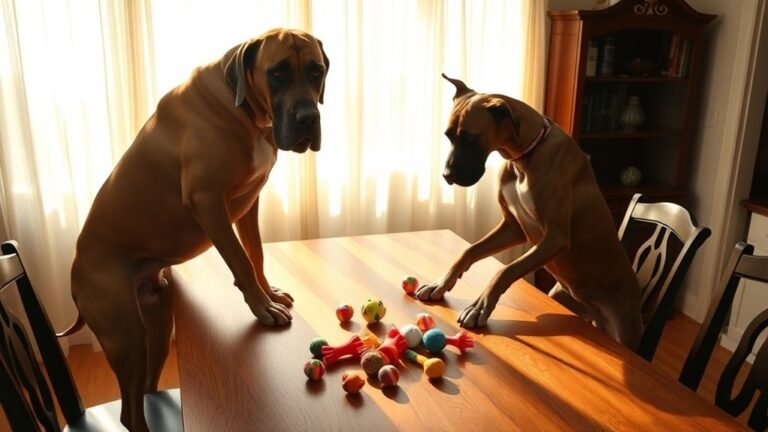
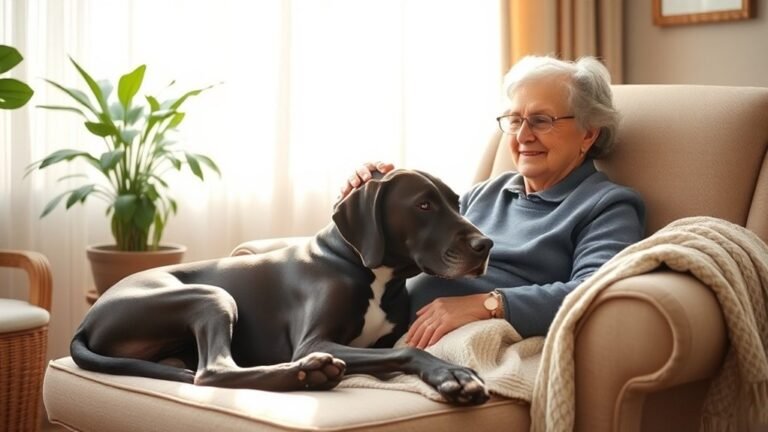
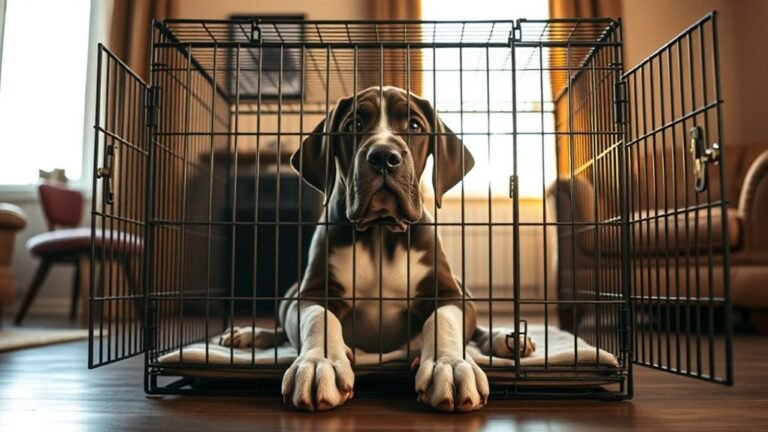
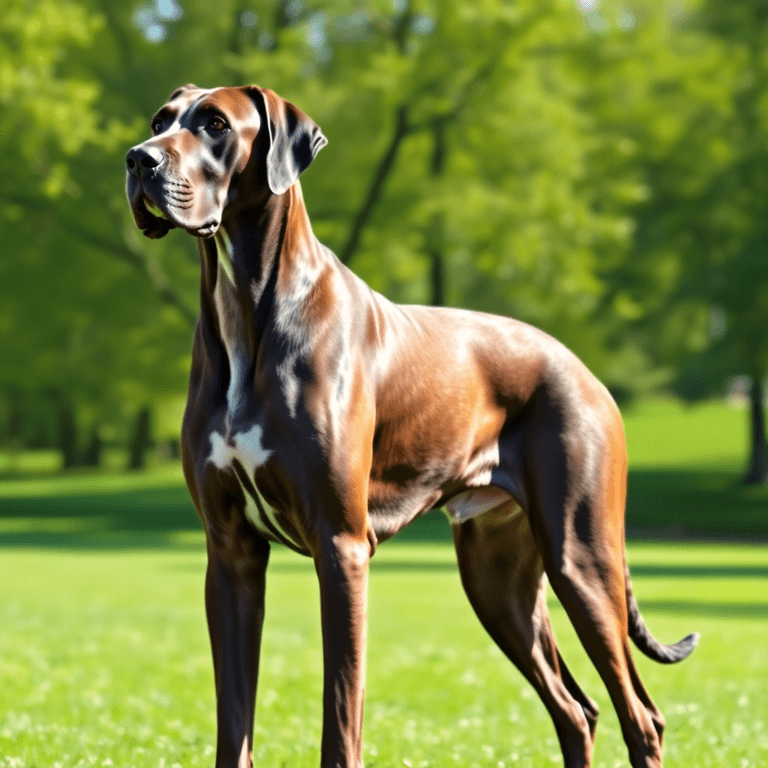
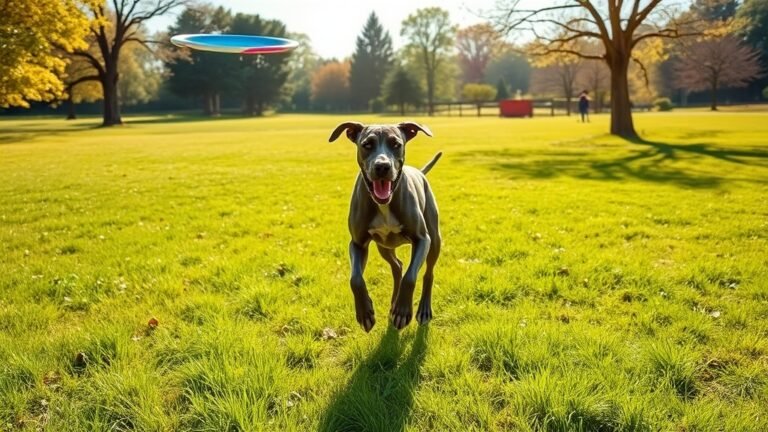
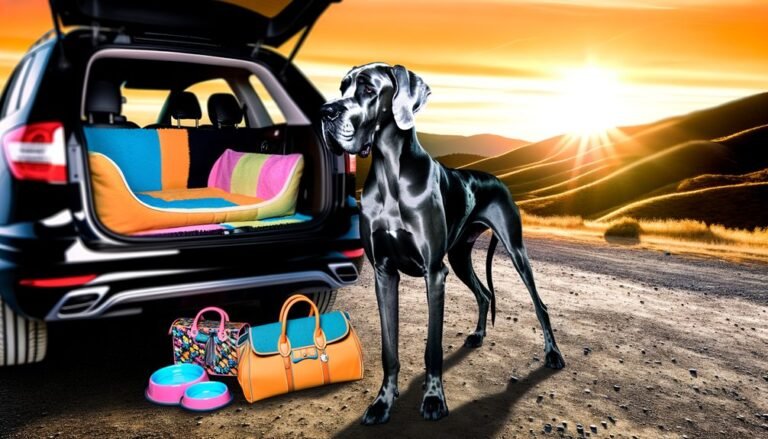
One Comment